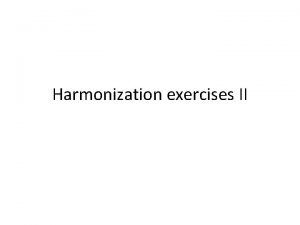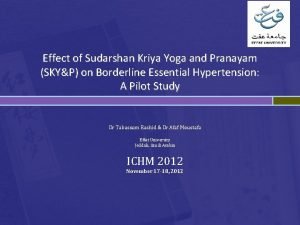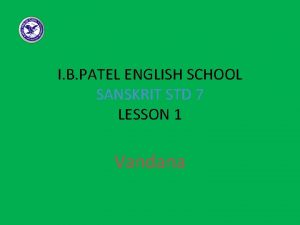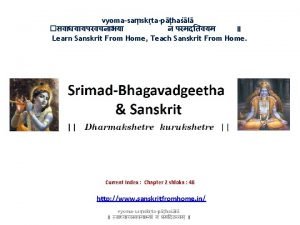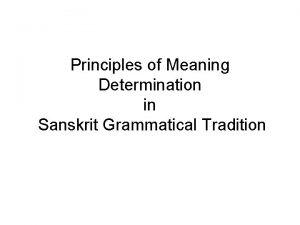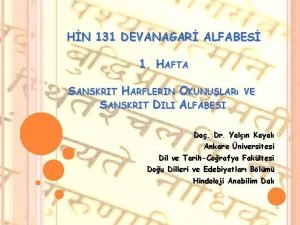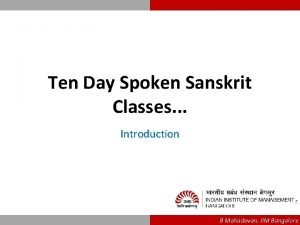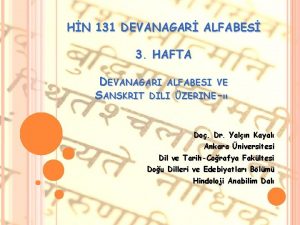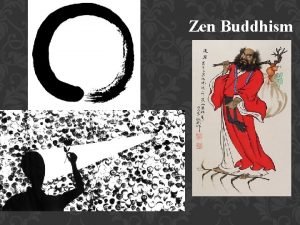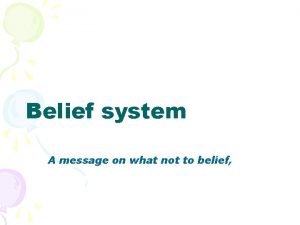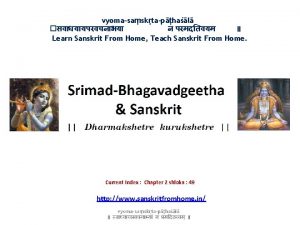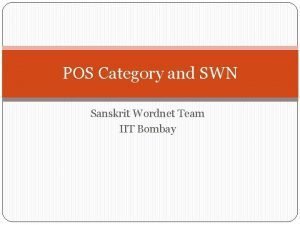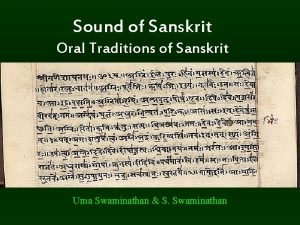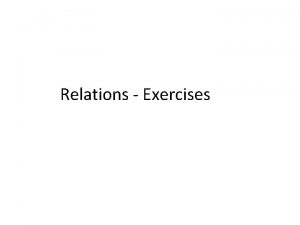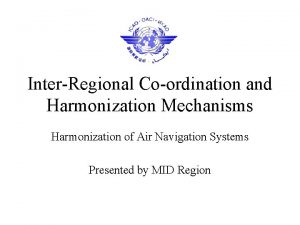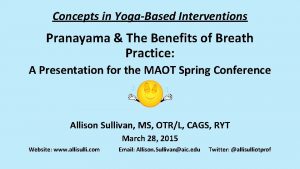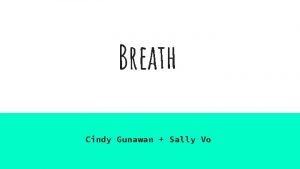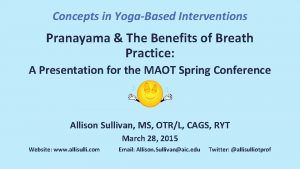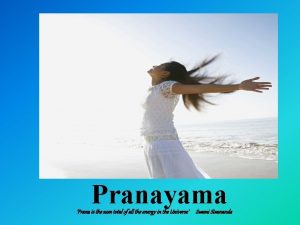Harmonization exercises II Pranayama The Sanskrit word meaning


























- Slides: 26

Harmonization exercises II

Pranayama • The Sanskrit word meaning "extension of the prāṇa or breath" or "extension of the life force„. • Prana - life force, or vital energy • Ayāma - to extend or draw out. • The role of breath is very important in the practice of yoga position.

• In yoga, breathing is the most central and vital practice. • Pranayama, the control of one's energy through the breath, is one of Patanjali's Eightfold Path and an integral part of modern or traditional hatha yoga practice. • The complete yogic breath itself has four parts: the inhalation (puraka), the retention (kumbhaka), the exhalation (rechaka), and the absence of breath within the body (shunyata).

• The complete yogic breath teaches us to use three anatomical parts of our lungs. • We also learn to use these parts of the lungs through various asanas. • The three parts of the breath: 1. abdominal ( Diaphragmatic breathing) 2. mid-chest breathing (Chest breathing) 3. upper-chest breathing (Collarbone/Clavicular) breathing)

1. Abdominal or Diaphragmatic Breathing • With an inhalation, the diaphragm moves downwards compressing the abdominal organs so that the abdominal wall extends outward. With an exhalation the diaphragm moves upward again and the abdominal wall flattens. • In contrast to the inhalation, the exhalation is a passive process. • The abdominal breath forms the basis of breathing and promotes relaxation.

2. Chest Breathing • With an inhalation, the ribs are lifted so that the chest expands. With an exhalation, the ribs return to their original position. The air flows into the middle lobes of the lungs. • The lungs are not filled as much as in abdominal breathing. • This breathing occurs automatically in stressful situations, due to nervousness or tension.

• • 3. Collarbone (Clavicular) Breathing With this type of breathing the air flows into the top of the lungs. With an inhalation, the upper part of the chest and collarbones are lifted and with an exhalation, they lower again. The breath is very shallow and rapid. This type of breathing occurs in situations of extreme stress and panic, or where there is great difficulty in breathing.

• A full yogic breath is like a slow wave: first filling the abdominal parts of the lungs fully, then the intercostals, and finally, the subclavial parts. • In a healthy and natural breath, all three variations occur. • The exhalation is slightly slower then the inhalation - until the lungs are completely empty (exhalation should last approximately twice as long as the inhalation).

• The basic yoga breath should be silent and through the nose (because the air is filtered, moistened and warmed within the nose).

• A frequent mistake in breathing is drawing the abdomen in as the chest expands, rather than relaxing the abdomen forwards. • All exercises in Yoga, including the breath exercises, should be practiced slowly and without unnecessary tension - without ambition or competition.

• Once we become aware of our breathing and recognize that it is the way in which we can control the energy of our body and mind, we can begin to use it“. • Without proper breathing, hatha yoga is simply a physical exercise.

• When we start to move with the breath, we experience a change in our state of mind. We become relaxed, focused, and peaceful. • With concentration, we can send the energy of the breath throughout the body, releasing tensions, supplying strength, and bringing stillness to areas where we are troubled (pain).

• The breath is also a useful tool for meditation.

• In Yoga there are five classical sitting positions: • Sukhasana - Comfortable Pose (cross-legged) • Siddhasana - Pose of the Adept • Vajrasana - Sitting on the Heels • Ardha Padmasana - Half-Lotus • Padmasana - Lotus

Savasana


Position of the Hands • Particular Mudras are used with the breathing and concentration exercises and also for meditation. A Mudra is a position or gesture that is practised for a specific purpose or expression.

Chin Mudra • In the meditation posture, place the hands on the knees with palms facing up. Thumb and index finger touch each other and the other three fingers remain straight but relaxed. • Chin Mudra represents the union of the cosmic with the individual consciousness. The index finger represents individual consciousness and the thumb - cosmic consciousness.

Neti (cleansing of the nostrils and sinuses) • Neti is one of the classical purification techniques in Yoga. A "Neti pot" is used for this procedure. The spout has a conical shape that fits easily into the nostrils. The Neti pot is filled with comfortably warm and slightly salted water. The head is held over the sink and turned to the right. The spout is held into the left nostril and the water is allowed to run into the left nostril and out of the right. After that the water is run through the right nostril and out of the left.

• This practice has a refreshing effect, brings fresh blood flow to the forehead and nose area, purifies the nose and sinuses and strengthens the respiratory system.


Pranayama – Nadi Shodhana • Nadi Shodhana belongs to the basic exercises of Pranayama. Due to the strong balancing effect on the autonomic nervous system, the practice of Nadi Shodhana is not only helpful in breath therapy, but also has a very positive effect on the state of health in many other medical conditions.

• Nadi is the Sanskrit word for the nerve pathways and energy channels; Shodhana means to purify. The better and easier our lifeforce can flow through the nadis, the healthier and more vital we feel.

• Ida, Pingala, and Sushumna: • Ida is activated when breathing through the left nostril – this nadi corresponds to the parasympathetic nervous system; • Pingala is activated through the right nostril – this nadi corresponds to the sympathetic nervous system; • Sushumna runs centrally along the spine and corresponds with the central nervous system.

• Practice of Nadi Shodhana level I: Sit comfortably on a chair or on the floor, the spine should be straight. The tips of the index and middle finger of the right hand are placed in the middle of the forehead. The right nostril is closed with the thumb and twenty relaxed and slightly deeper breaths are taken through the left nostril. Then the right nostril is opened and the left nostril is closed using the right ring finger. Twenty inward and outward breaths are taken through the right nostril. This breathing exercise has a strong calming effect on the nervous system, as well as on the cardiovascular and digestive systems.

 Sanskrit pranayama
Sanskrit pranayama The word pranayama
The word pranayama Chakra meaning in sanskrit
Chakra meaning in sanskrit Mandala what is
Mandala what is Sudarshan kriya pranayama
Sudarshan kriya pranayama Types of pranayam
Types of pranayam What is salary harmonization
What is salary harmonization Global harmonization task force
Global harmonization task force Data dictionary best practice
Data dictionary best practice Yoga berasal dari bahasa sansekerta yang berarti
Yoga berasal dari bahasa sansekerta yang berarti Mandala sanskrit
Mandala sanskrit Pathami sanskrit nityam
Pathami sanskrit nityam Learnsanskritfromhome
Learnsanskritfromhome Determination in sanskrit
Determination in sanskrit Latin sanskrit similarities
Latin sanskrit similarities Devanagari alfabesi
Devanagari alfabesi Desa berasal dari kata
Desa berasal dari kata Ten day spoken sanskrit classes
Ten day spoken sanskrit classes Sanskrit alfabesi çeviri
Sanskrit alfabesi çeviri Dhyana sanskrit
Dhyana sanskrit Yajurveda chapter 40 verse 9
Yajurveda chapter 40 verse 9 Hindu margas
Hindu margas Sanskrit from home
Sanskrit from home Sanskrit morphology
Sanskrit morphology Perspective in sanskrit
Perspective in sanskrit Sanskrit wordnet
Sanskrit wordnet Fascmile
Fascmile
